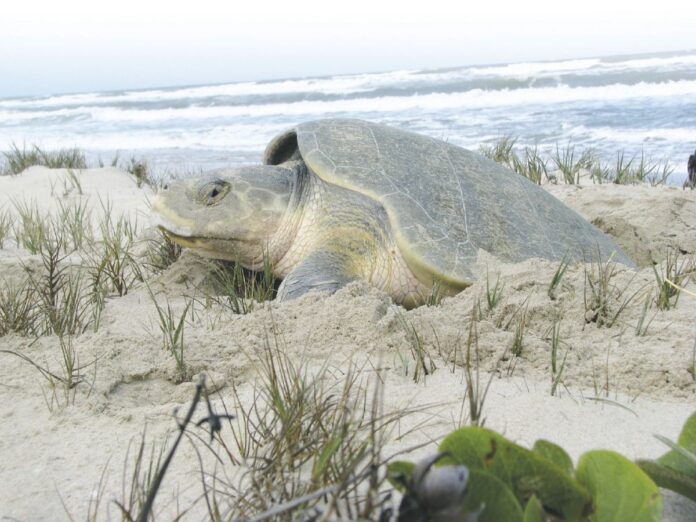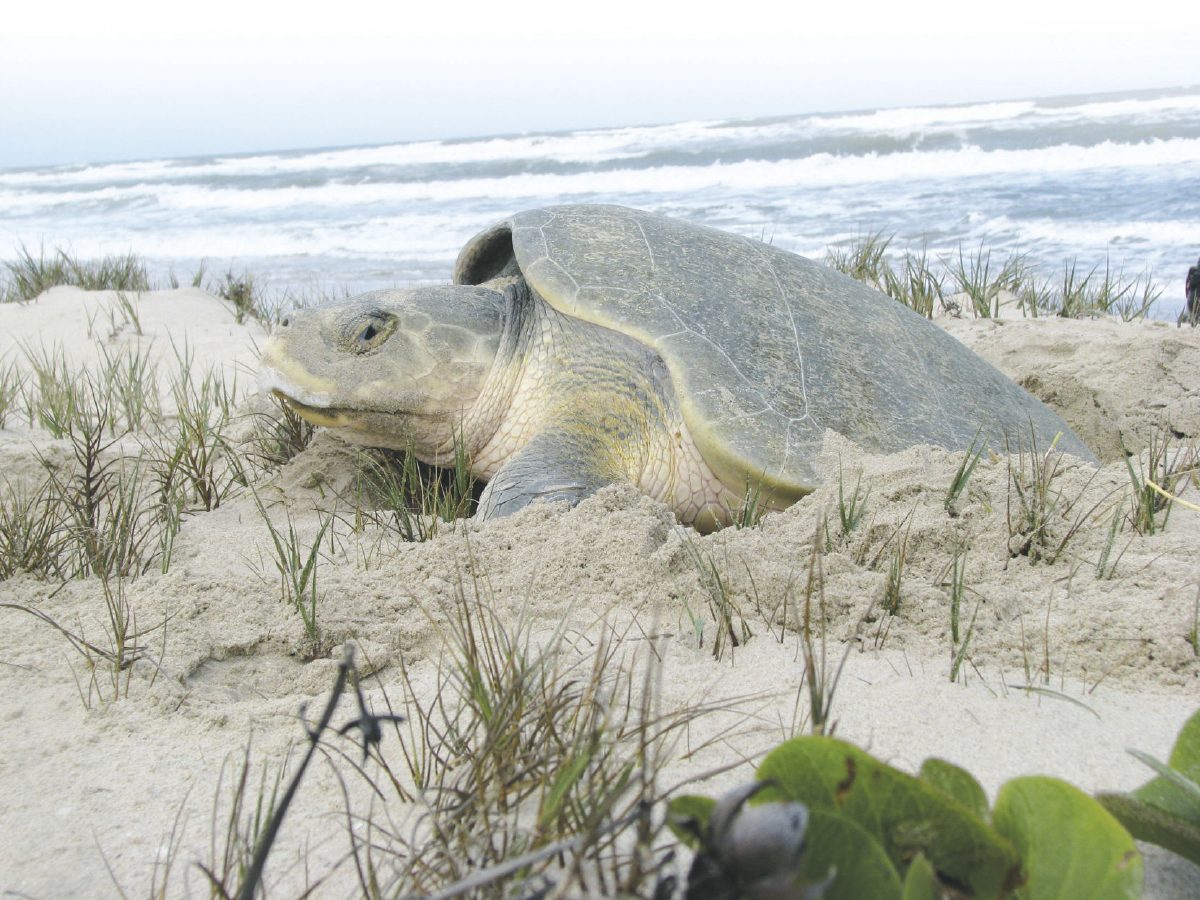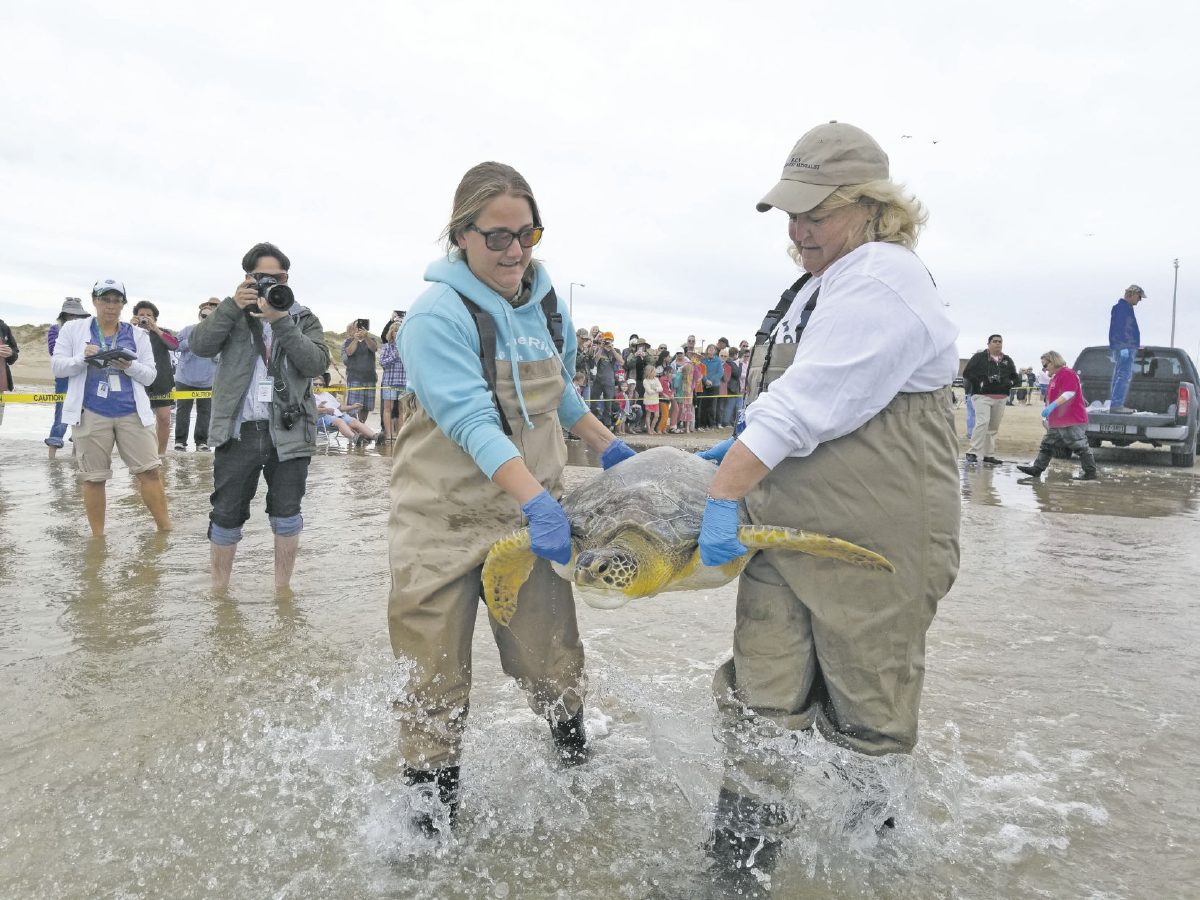HARLINGEN — The mysterious lives of sea turtles, creatures pulled by instinct and the ebb and flow of moon and tide across vast oceanic distances, make estimating their numbers notoriously difficult.
But a recent global study of the planet’s sea turtles by a team of scientists from Greece and Australia reveals a surprising twist to decades or even centuries of decline: Conservation efforts are working.
The study published in Science Advances focused on 17 ocean regions, and concluded that in 12 of those 17 units, the populations of six of the world’s seven sea turtle species are increasing.
One of those is the Gulf of Mexico.
“Yes, we are also hearing and seeing good trends in populations, especially in the Atlantic populations,” said Jeff George, executive director of Sea Turtle Inc. on South Padre Island.
Of the world’s seven sea turtle species, five occur in the Gulf of Mexico. There is the critically endangered Kemp’s ridley, which nests from Galveston south into Mexico, the green turtle, hawksbill, leatherback and loggerhead. Only olive ridleys (Pacific, Indian oceans) and flatback sea turtles (Australian north coast) do not swim in the gulf.
“Six of the seven sea turtle species are currently listed as vulnerable, endangered or critically endangered … The flatback turtle (Natator depressus) remains data-deficient,” the study concluded.
Why the numbers are up
Sea turtles have proved vulnerable to a number of human activities, such as falling foul of the nets of fishing and shrimp boats and both adults and their eggs being served up as local cuisine.
Only in the 1950s did sea turtle conservation begin to become a serious concern, and efforts to preserve turtles since then have included legal protections prohibiting the harvest of sea turtles and their eggs, setting aside protected nesting zones and mandatory turtle excluder devices on shrimping vessels.
“I grew up in Key West, and when I was a kid they had turtle kraals (sea pens) where they kept green sea turtles,” recalled Tony Reisinger, Texas Sea Grant’s Cameron County Coastal and Marine Resources agent. “My parents ate sea turtles when I was a young kid in Key West.
“And sea turtle eggs, when we lived in Florida,” he added, “my father took me out and showed me how to look for sea turtle eggs — it was an accepted food-gathering method.”
Reisinger is now a formidable protector of sea turtles, and has worked for years promoting the proper use of turtle excluder devices, known as TEDs, by gulf shrimpers.
These devices allow a sea turtle to escape being ensnared in nets targeting shrimp, which in the past would have led to its death by drowning. The global turtle study specifically singles out TEDs as being a major factor in the rebound of sea turtle species.
“We just concluded a grant where we went all the way around the Gulf of Mexico working with individual fishermen and helping them tweak their turtle excluder devices, and we’re very proud of it,” Reisinger said. “We’ve seen an increase in the population so it reflects on our work directly, we think. We’re happy with it.”
Credit teamwork
Conservationists in Mexico also are involved with sea turtle protection and recovery, and Sea Turtle Inc. and the Gladys Porter Zoo in Brownsville have been working with them to protect turtles and nesting areas in both the Gulf of Mexico and the eastern Pacific Ocean.
Zoo experts are helping along the 16-mile-long Playa de Rancho Nuevo area of Mexico’s Tamaulipas state to study and protect the Kemp’s ridley nesting population.
Females come ashore there, usually after a storm, in large groups of hundreds or even thousands at a time. These waves of turtles are known to locals as arribadas, or “arrivals” in Spanish.
Sea Turtle Inc. is helping on the Pacific coast of Mexico with efforts to preserve Pacific leatherback turtles, the giants of the turtle world which can grow to more than 1,500 pounds. The only larger reptiles on the planet are three species of crocodilians.
“The conservation alarms are for the Pacific leatherback,” said George of Sea Turtle Inc. “The eastern Pacific population of nesting females is down to about 300 and western Pacific females is at about 2,000.
“These are dreadfully close to extinction,” he added. “Sea Turtle Inc. funded a portion of the work in Mexiquillo, Michoacan, Mexico, which is considered the third-largest nesting beach for eastern Pacific leatherbacks. In 2017, they had only 50 to 60 nests.”
Reisinger said the contribution of shrimpers should not be ignored when it comes to praises for the sea turtle bounce-back in the gulf. The turtle excluder devices were almost universally despised when federally mandated for shrimp boats in 1987, but the industry has made the best of the regulatory situation.
“They still lose shrimp, OK? I forget the percentage but its like if somebody was going to take some out of your paycheck every year, say 10 percent just for a guess, you wouldn’t like that,” Reisinger said.
“Anyway, it’s working, and the fishermen have adapted to it,” he added.
Gulf of hope
To illustrate the difficulties of estimating sea turtle populations look no further than Dr. Donna Shaver, chief of the Division of Sea Turtle Science and Recovery at Padre Island National Seashore near Corpus Christi.
Shaver has been working to save Kemp’s ridleys and other gulf sea turtles since 1980. Last month, the International Sea Turtle Society gave her its Lifetime Achievement Award for her efforts.
“That’s a tricky thing to get a hold of, and you would think it might not be, but actually it is,” she said. “To estimate the number of females what we need to do is look at the number of nests from a year.”
A total of 27,000 Kemp’s ridley nests were recorded last year, practically all of them on Playa de Rancho Nuevo in Mexico. That number is a vast improvement from the 702 nests found along the Texas and Mexico coastline in 1985.
Last year in Texas, 353 Kemp’s ridley nests were recorded between Galveston and Boca Chica Beach. The Padre Island National Seashore recorded 219 nests, South Padre Island had 70 and Boca Chica had 23. All are records for those areas.
Since female turtles don’t lay eggs every year, researchers are reduced to puzzling out just how often they nest and using a mathematical formula based on a female laying eggs every two or three years to gauge population.
“But that’s tricky, too, because our latest research based on long-term tagging is the last few years it’s actually up to 3.5 years on average” that a Kemp’s ridley female comes ashore to lay eggs, Shaver said.
Shaver is certain about one statistic, and that’s the number of Kemp’s ridley nests found on Texas beaches when she started in 1980: One every three years.
“For the future, what I see is, we’ve got to keep up our efforts, although last year was a good year and we were happy with the findings,” she said of the Kemp’s ridley. “The species is certainly not recovered and we could have a decline again this year since the numbers have been fluctuating.”
Shaver said turtle conservationists in Texas, like those at her research facility at Padre Island National Seashore, Sea Turtle Inc. and the Gladys Porter Zoo, also are working to save the endangered green turtle.
While few female greens nest along the Texas coast — just 28 nests were found last year — most of the thousands of cold-stunned turtles rescued this winter in the Laguna Madre were juvenile green turtles hatched elsewhere.
What can’t be challenged based on the latest science is that 70 years of sea turtle conservation efforts are showing definite signs of becoming a global success story.
“There’s more work to be done, but we can do it with more of a smile on our face than what we had way back when I first started,” Shaver said. “There were some people who told me they thought it might even be too late for the Kemp’s ridley.
“Thank goodness we didn’t listen.”
Smallest of the five sea turtle species in the gulf
Critically endangered 23 to 27 inches long, average weight 100 pounds
Adults olive green above, pale yellow below
Eats crabs, shrimp, clams, sea urchins
Warm-water turtle but ranges as far north as Nova Scotia
Only nests along Texas and Mexico gulf coast
Source: National Park Service
1. Hawksbill (gulf, critically endangered)
2. Green (gulf, endangered)
3. Leatherback (gulf, vulnerable)
4. Olive ridley (vulnerable)
5. Kemp’s ridley (gulf, critically endangered)
6. Flatback (insufficient data)
7. Loggerhead (gulf, vulnerable)
353 – Kemp’s Ridley
9- Loggerhead
28 Green turtle (six on South Padre Island)






